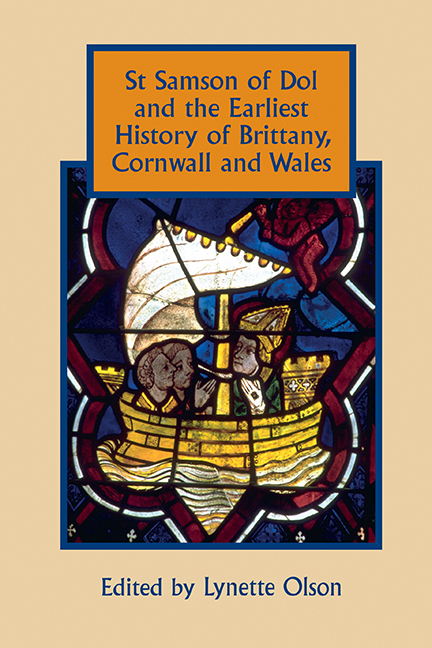Book contents
- Frontmatter
- Contents
- List of Tables
- Editor's Preface
- Map: Places associated with St Samson in the First Life
- 1 Introduction: ‘Getting Somewhere’ with the First Life of St Samson of Dol
- 2 A Family and its Saint in the Vita Prima Samsonis
- 3 La Circulation de l'information dans la Vie ancienne de s. Samson de Dol et la question de sa datation
- 4 The Hare and the Tortoise? Vita Prima Sancti Samsonis, Vita Paterni, and Merovingian Hagiography
- 5 Columbanus, the Britons, and the Merovingian Church
- 6 Apostolic Authority and Celtic Liturgies: from the Vita Samsonis to the Ratio de cursus
- 7 The Representation of Early British Monasticism and Peregrinatio in Vita Prima S. Samsonis
- 8 Present and Yet Absent: the Cult of St Samson of Dol in Wales
- Bibliography
- Index
- Studies in Celtic History
4 - The Hare and the Tortoise? Vita Prima Sancti Samsonis, Vita Paterni, and Merovingian Hagiography
Published online by Cambridge University Press: 05 July 2018
- Frontmatter
- Contents
- List of Tables
- Editor's Preface
- Map: Places associated with St Samson in the First Life
- 1 Introduction: ‘Getting Somewhere’ with the First Life of St Samson of Dol
- 2 A Family and its Saint in the Vita Prima Samsonis
- 3 La Circulation de l'information dans la Vie ancienne de s. Samson de Dol et la question de sa datation
- 4 The Hare and the Tortoise? Vita Prima Sancti Samsonis, Vita Paterni, and Merovingian Hagiography
- 5 Columbanus, the Britons, and the Merovingian Church
- 6 Apostolic Authority and Celtic Liturgies: from the Vita Samsonis to the Ratio de cursus
- 7 The Representation of Early British Monasticism and Peregrinatio in Vita Prima S. Samsonis
- 8 Present and Yet Absent: the Cult of St Samson of Dol in Wales
- Bibliography
- Index
- Studies in Celtic History
Summary
In the attempt to achieve a better understanding of the First Life of St Samson (VIS), which is potentially a key text for the understanding of the early christian history of both Brittany and western Britain, but whose dating, authorship, and historical reliability continue to present problems, the investigation of the text's literary sources must play an important part. François Kerlouégan, Neil Wright, Bernard Merdrignac, and Joseph-Claude Poulin have all made substantial contributions towards identifying the literary models for this and other works of Breton hagiography: this has helped to establish anterior and posterior dating limits for the composition of the work, and to build up a picture of the literary culture of the author or authors.
Some of these models are popular texts that were diffused throughout Latin Christendom in the early middle ages (for instance the Life of St Martin by Sulpicius Severus, a blueprint for hagiographers everywhere in the Western Church), but one source that has the potential to provide more precise information about the contacts available to the author is the Vita Sancti Paterni (VP) by Venantius Fortunatus. St Paternus, according to this Vita, was the son of a noble Aquitanian family who became a monk and hermit in the Cotentin and then at Sciscy (the future Saint-Pairsur- Mer) on the coast of Normandy, and at the age of seventy was appointed bishop of Avranches by King Childebert I (ob. 558). He probably died in 564. His Life was written by Fortunatus, at the request of a certain Abbot Martianus, probably not long after the saint's death and certainly before ca 600 when Fortunatus himself died – thus, some time in the last third of the sixth century, considerably earlier than VIS, which is unlikely to be earlier than ca 650. Robert Fawtier was the first to note the similarities between the two texts, and Bernard Merdrignac in 1988 produced a table identifying a range of similar narrative motifs (see Table 4.1).
- Type
- Chapter
- Information
- Publisher: Boydell & BrewerPrint publication year: 2018
- 1
- Cited by



